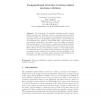Free Online Productivity Tools
i2Speak
i2Symbol
i2OCR
iTex2Img
iWeb2Print
iWeb2Shot
i2Type
iPdf2Split
iPdf2Merge
i2Bopomofo
i2Arabic
i2Style
i2Image
i2PDF
iLatex2Rtf
Sci2ools
COSIT
2001
Springer
2001
Springer
Computational Structure in Three-Valued Nearness Relations
The development of cognitively plausible models of human spatial reasoning may ultimately result in computational systems that are better equipped to meet human needs. This paper explores how human subjects perceive the qualitative spatial relation nearness within an environmental space. Based on experimental data, a three-valued nearness relation is analysed in two stages. First, the results are analysed with special reference to the existence of subsets of candidate landmark places, from which nearness relations between other places may be partially inferred. Second, the desirable properties of such landmark sets are considered and some of their formal properties are presented. These properties are then considered in the light of the data furnished by the experiment. The paper concludes with a discussion of the significance of the analyses and the scope for further work in this area.
| Added | 28 Jul 2010 |
| Updated | 28 Jul 2010 |
| Type | Conference |
| Year | 2001 |
| Where | COSIT |
| Authors | Matt Duckham, Michael F. Worboys |
Comments (0)

